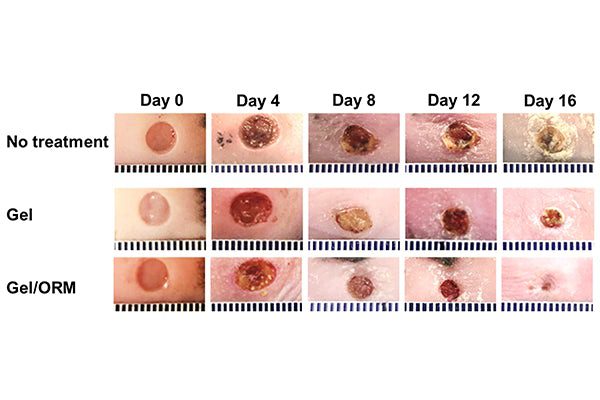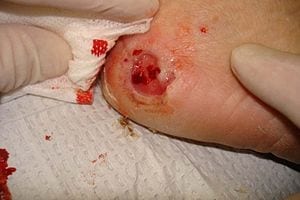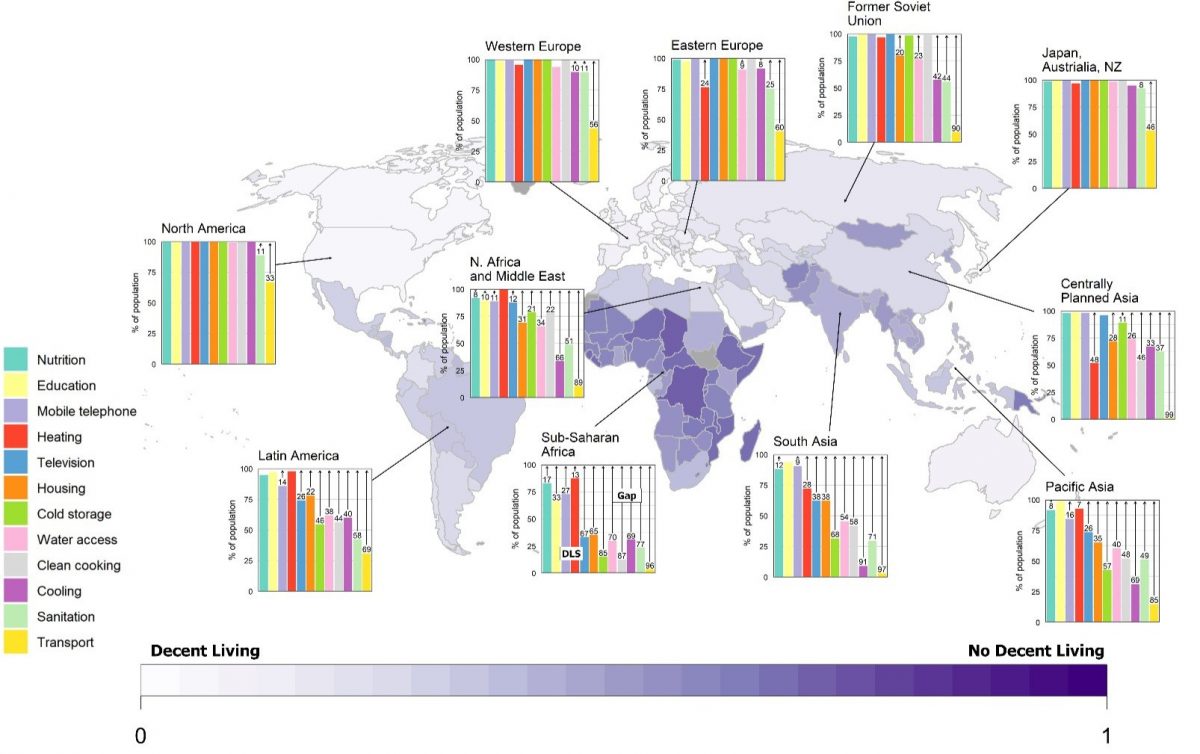
Representative images of the wounds treated with or without gel and oxygen-release microspheres for 16 days.
Jianjun Guan’s lab develops potential drug-free treatment for chronic wounds
About one-fourth of people with diabetes develop painful foot ulcers, which are slow to heal due to low oxygen in the wound from impaired blood vessels and increased inflammation. These wounds can become chronic, leading to poor quality of life and potential amputation.
Jianjun Guan, a professor of mechanical engineering & materials science in the McKelvey School of Engineering at Washington University in St. Louis, has developed a hydrogel that delivers oxygen to a wound, which decreases inflammation, helps remodel tissue and accelerates healing. Results of the work, which were in a mouse model, are published Aug. 28 in Science Advances. Ya Guan, a doctoral student, and Hong Niu, a postdoctoral research associate, both in Guan’s lab, are co-first authors.
“The oxygen has two roles: one, to improve skin cell survival under the low-oxygen condition of the diabetic wound; and two, oxygen can stimulate the skin cells to produce growth factors necessary for wound repair,” Guan said.
Tissues in the body require oxygen to survive and need even more when tissue is injured. While there are several existing treatments for chronic wounds in people with diabetes, the most common treatment is dozens of sessions in a hyperbaric oxygen chamber, but its effectiveness is inconsistent and includes the risk of oxygen toxicity.
Guan’s hydrogel delivers oxygen to the wound using microspheres that gradually release oxygen to interact with the cells through an enzyme on their surface that converts what is inside of the microsphere into oxygen. The oxygen is delivered to the wound over about a two-week period, and inflammation and swelling decrease, prompting healing.
In the mice, wounds treated with the hydrogel containing the oxygen-releasing microspheres had a greater rate of closure than wounds treated with only the gel or those with no treatment. By day 16, the wounds treated with the hydrogel had reduced to 10.7%. Those treated with the gel only were reduced to 30.4%, and those with no treatment had reduced to 52.2%.
In addition, the wounds treated with the hydrogel containing the oxygen-releasing microspheres had the thickest epidermis on day 8, but the thinnest by day 16, indicating the wound was healing and inflammation was reduced.
Over the past 14 years, Guan has been developing this type of gel, which has nearly 70 different functions and chemical structures.
“The gel is a liquid before we put it into the skin tissue, so it is easy to mix in the microspheres,” he said. “Once we put the mixture of the gel and the microspheres into the wound, it becomes a solid because it is temperature-sensitive — at lower temperatures it is a liquid, and at body temperature it’s a solid.”
One risk of delivering oxygen to wounds is delivering too much, which creates reactive oxygen species (ROS), which can damage or kill cells at elevated levels. Guan’s hydrogel is able to scavenge for ROS content and destroy it, eliminating any risk.
Next, Guan’s team plans to use the hydrogel in a large animal model with the expectation of future human clinical trials.
“This represents a new therapeutic approach to accelerating healing of chronic diabetic wounds without drugs,” Guan said. “It also has the potential to treat other diseases in which oxygen is low, such as peripheral artery disease and coronary heart disease.”
Original Article: Oxygen-delivering hydrogel accelerates diabetic wound healing
More from: McKelvey School of Engineering
The Latest Updates from Bing News & Google News
Go deeper with Bing News on:
Oxygen-delivering hydrogel
- Skin Care Newson May 3, 2024 at 5:01 pm
Apr. 2, 2024 — Polymer-based hydrogels are used to treat skin ailments and in tissue engineering because of their ability to retain water, deliver drugs ... where it binds oxygen, is also ...
- 5 Best Home Oxygen Concentrators Of 2024on April 30, 2024 at 5:38 am
Commissions we earn from partner links on this page do not affect our opinions or evaluations. Our editorial content is based on thorough research and guidance from the Forbes Health Advisory Board.
- Study uncovers the secret of long-lived stem cellson April 29, 2024 at 5:00 pm
HSCs are blood-forming cells—they give rise to rapidly dividing progenitor cells, which in turn generate hundreds of billions of cells to fulfill the daily demand of oxygen-delivering red blood ...
- 10 Best Portable Oxygen Concentrators Of 2024on April 11, 2024 at 9:41 am
Commissions we earn from partner links on this page do not affect our opinions or evaluations. Our editorial content is based on thorough research and guidance from the Forbes Health Advisory Board.
- Manufacturing Leaders in Biomedical Hydrogel Innovationson March 31, 2024 at 5:00 pm
Manufacturers are now able to produce hydrogels that are stronger, more elastic, and capable of delivering drugs or supporting tissue growth, revolutionizing product lines in both medical and personal ...
Go deeper with Google Headlines on:
Oxygen-delivering hydrogel
[google_news title=”” keyword=”oxygen-delivering hydrogel” num_posts=”5″ blurb_length=”0″ show_thumb=”left”]
Go deeper with Bing News on:
Chronic wounds
- Fresh hope for chronic woundson May 8, 2024 at 7:44 am
More than 6.5 million Americans are affected by chronic wounds annually, according to the National Institutes of Health (NIH). It’s a challenging problem. An open wound that won’t heal can result in ...
- Transformative Discovery Could Solve Billion-Dollar Problem of Poorly Managed Wound Healingon May 7, 2024 at 7:50 pm
Scientists have discovered a crucial protein that enhances wound healing and muscle regeneration, a process often impaired by conditions such as diabetes and aging. Researchers have discovered an ...
- Four Groundbreaking Studies From NGS Pioneers MicroGenDX Were Presented for the First Time to Attendees of the Wound Healing Society 2024on May 6, 2024 at 11:09 am
Findings From These Studies Could Save Thousands of Lives Through Better Understanding the Mechanistic Basis of Chronic Wound InfectionORLANDO, FL / ACCESSWIRE / May 6, 2024 / MicroGenDX, a global lea ...
- Wound Management Devices Market Size Explorer’s Handbook to Unveiling Growthon May 5, 2024 at 10:11 pm
Download Free Sample of This Strategic Report with Industry Analysis @ –- Wound Management Devices Market is valued approximately at USD 14 billion in 2019 and is anticipated to grow with a growth ...
- What is ‘tranq’ and why do police carry wound care kits because of it?on May 5, 2024 at 2:15 am
Xylazine, an animal tranquilizer, was found in 42% of lab-tested Mass. drug samples earlier this year, data shows — the highest percentage the state has seen yet.
Chronic wounds
[google_news title=”” keyword=”chronic wounds” num_posts=”5″ blurb_length=”0″ show_thumb=”left”]










